The Talking Dead
Shaping game design that connects VR and public speaking
The Challenge
We were tasked with creating a new game or tool for the livestreaming platform Twitch. My team was interested in helping streamers increase their public speaking confidence through VR and audience-participation games.
The Research
Over one week of exploratory research, we identified user needs and potential pitfalls to set a course for game design. I then led three rounds of user testing at increasing fidelity, from paper prototypes to the live game in VR.
The Impact
Exploratory research redirected away from “therapeutic” design. Three user testing cycles improved UI and design without slowing down the two-week coding timeline. Testing pointed to general challenges of integrating VR with audience participation games.
Quick Background: Twitch
This game design project was the culmination of the Masters class Twitch Game Design. We investigated and designed around new ways people connect through video games, specifically through livestream platforms like Twitch.
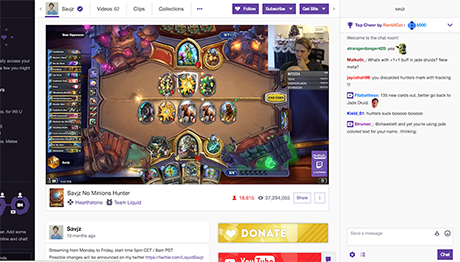
Twitch is a livestreaming platform mainly used for video games. Any user (streamer) can broadcast themselves playing a game to online viewers. The crowd of viewers can communicate through text chat (on the right sidebar).
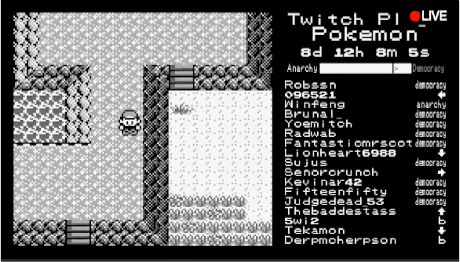
Audience participation games like Twitch Plays Pokemon let the chat play games through text input. This class investigated similar new ways in which streamers and viewers can interact together through streaming.
Our challenge was to “make something awesome” through crowd interaction on Twitch. From previous brainstorming, my team started with an inspiration. What if virtual crowds on Twitch could help streamers become better and less anxious public speakers? Could VR make this more immersive?
ONE WEEK
Exploratory Research: Guiding Game Design
With only four weeks to design and code, we had one (very part-time!) week for foundational research to guide our design. We prioritized quick methods to pressure test our design hunches.
Foundational Interviews
Part of the team conducted three foundational interviews on general public speaking anxiety, hoping to gain a deeper first-hand view. We presented early concepts as well to gut-check their reactions.
Previously, we did two in-depth interviews with semi-professional streamers (who stream for profit, but not full-time). These probed at their goals, pain points, and relationships with their streaming audience. Streamers are often looking for new ways to connect with their audience to foster community-building.
These interviews brought us closer to the communities we were designing for (though I wish we had more time for larger samples and deeper questioning that I normally would do). Of note, interviewees nixed original concepts related to purposeful heckling because they seemed too intense and negative.
“ Your heart starts pumping faster, your mouth goes dry. You don’t think as clearly. Either you speed up and go all over the place, or you slow down and get stuck.”
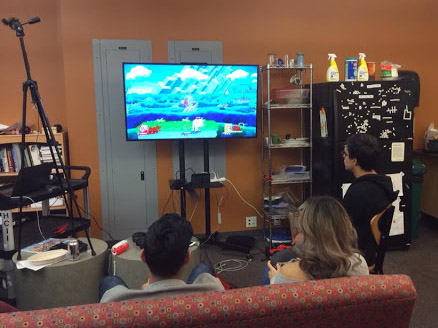
Seeing the Twitch chat was a huge factor in perceived anxiety for new streamers. Most of the streamers forgot about the camera and chat (especially in groups).
Ethnographic Observation
As an anthropologist at heart, I’m always on the lookout for ways to observe behavior that can’t always be voiced or self-reported. What do new streamers think and experience when starting out?
Masters students hosted a livestream charity event where people traded off streaming. This was a rare opportunity to observe novice streamers in person. I attended and observed a few new streamers in person, taking field notes and asking impromptu follow-up questions in context.
Many of these streamers weren’t actively engaging with the Twitch audience and seemed to not feel pressure or the need to perform or entertain. One streamer, however, had friends show up in chat and heckle them, creating distress. This streaming event ended up being distant from the normal streaming culture of 1-on1 audience engagement. Nonetheless, it suggested chat activity and awareness (esp negative) is a factor for new streamer anxiety.
With more time, I would have also liked to have done digital ethnographic work. Online observations could have given us greater context for how streamers entertain audiences and if/when they experience anxiety.
Literature Review
What is already known about VR, public speaking anxiety, and participation games? Our literature review tapped into extensive research on VR and public speaking anxiety in psychology and human-computer interaction.
VR has shown promise in creating immersion for simulated speaking therapy since the early 2000’s. Therapy for public speaking anxiety is extremely technical with a wide margin for potential harm if done incorrectly, however. This lit review was the single most important exploratory takeaway. It validated our thoughts on exploring the VR space related to public speaking.
However, a teammate and I advocated to move away from therapy because we didn’t have time or expertise to do it ethically. Instead, we pushed to make a game inspired by public speaking, or to address a less bold goal such as only strengthening improv skills.
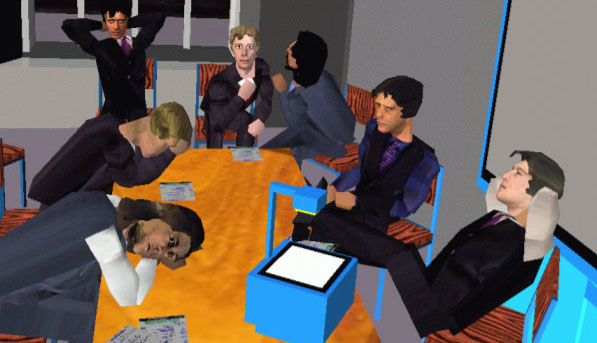
VR therapy for speaking anxiety has been used since the early 2000's, like this study testing various virtual audience reactions (Pertaub 2002). However therapy requires significant expertise and care, which our team couldn't deliver in four weeks.
SIDENOTE: DESIGN OVERVIEW
The Talking Dead
Our new goal was to make an audience participation game inspired by public speaking. Here’s an overview of our final design and process.
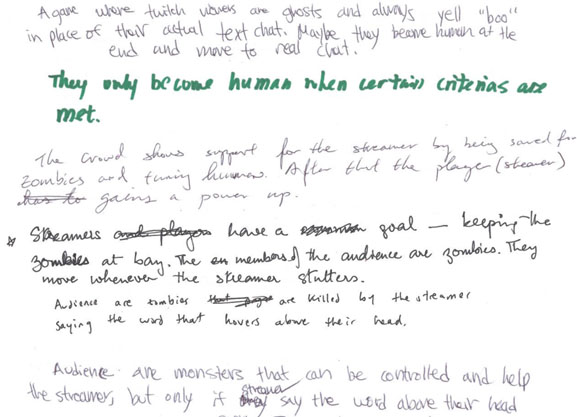
From research, we did a design thinking exercise “Round Robin” to quickly generate and collaborate on concepts.
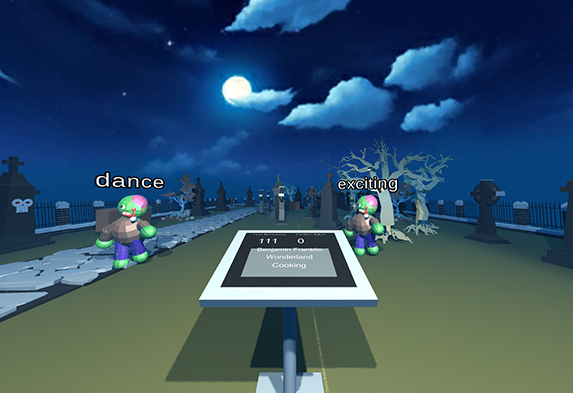
In The Talking Dead, streamers in VR have to improvise a story out loud. A prompt on the podium helps them start. Zombies approach the streamer with words on their heads. If the streamer uses the words in their story, the zombies dies. If the streamer is touched, its game over.
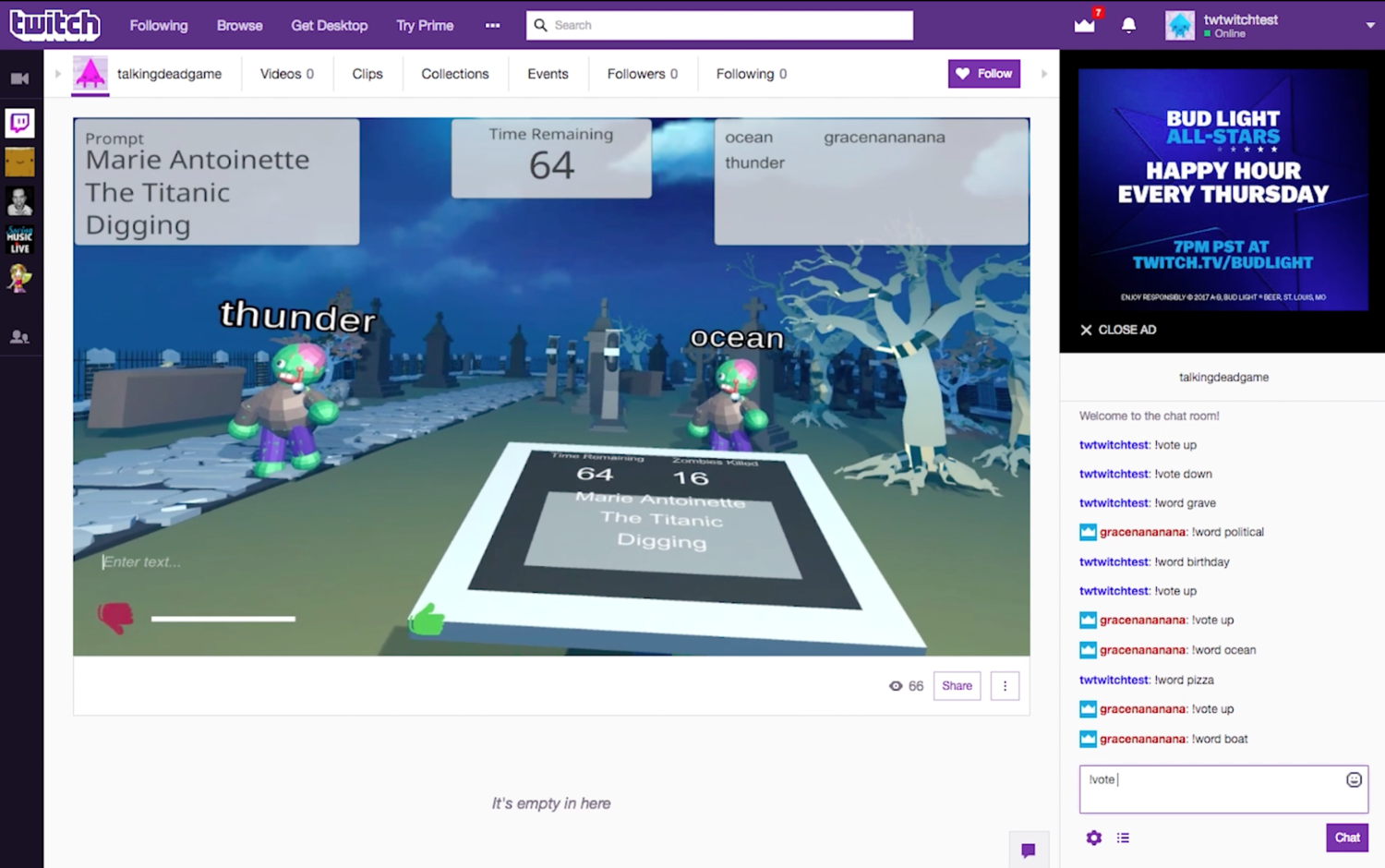
The game is connected live to Twitch, with a more detailed display for general viewers. It gives updates on current prompt, upcoming words, and up/down voted level of the performance.
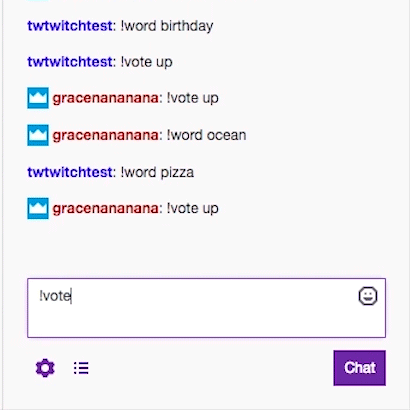
Viewers use chatbot commands to add words to upcoming zombies. They also vote on the quality of storytelling, which speeds up or slows down zombies.
VIDEO DEMO
THREE WEEKS
User Testing: From Paper to VR
I led user testing throughout the design and code process. It was important for us to do this continuously, at whatever fidelity we had at the time. This efficiently honed game design and UI as we went.
Paper Prototype Testing
Our first round of user testing happened before any code was written. At very low “paper prototype” fidelity, we could pressure test the basic design of the game and make quick improvements, without locking ourselves into hours of code.
We had classmates roleplay as both the audience members providing words and the zombies holding them. They slowly walked towards the “streamer” who told a story to “kill” the zombies and make them move backwards.
Several variations on the game were introduced to see what happened: adding a story prompt and adding audience voters to judge the quality of stories.
We found that without a prompt, streamers had little motivation to create a coherent story - they just yelled random sentences.
The audience voting further motivated streamers to create more interesting storiesIt seemed to cause some pressure, which could be a boon to the frenzied, funny storytelling we were after (but might also cause anxiety).
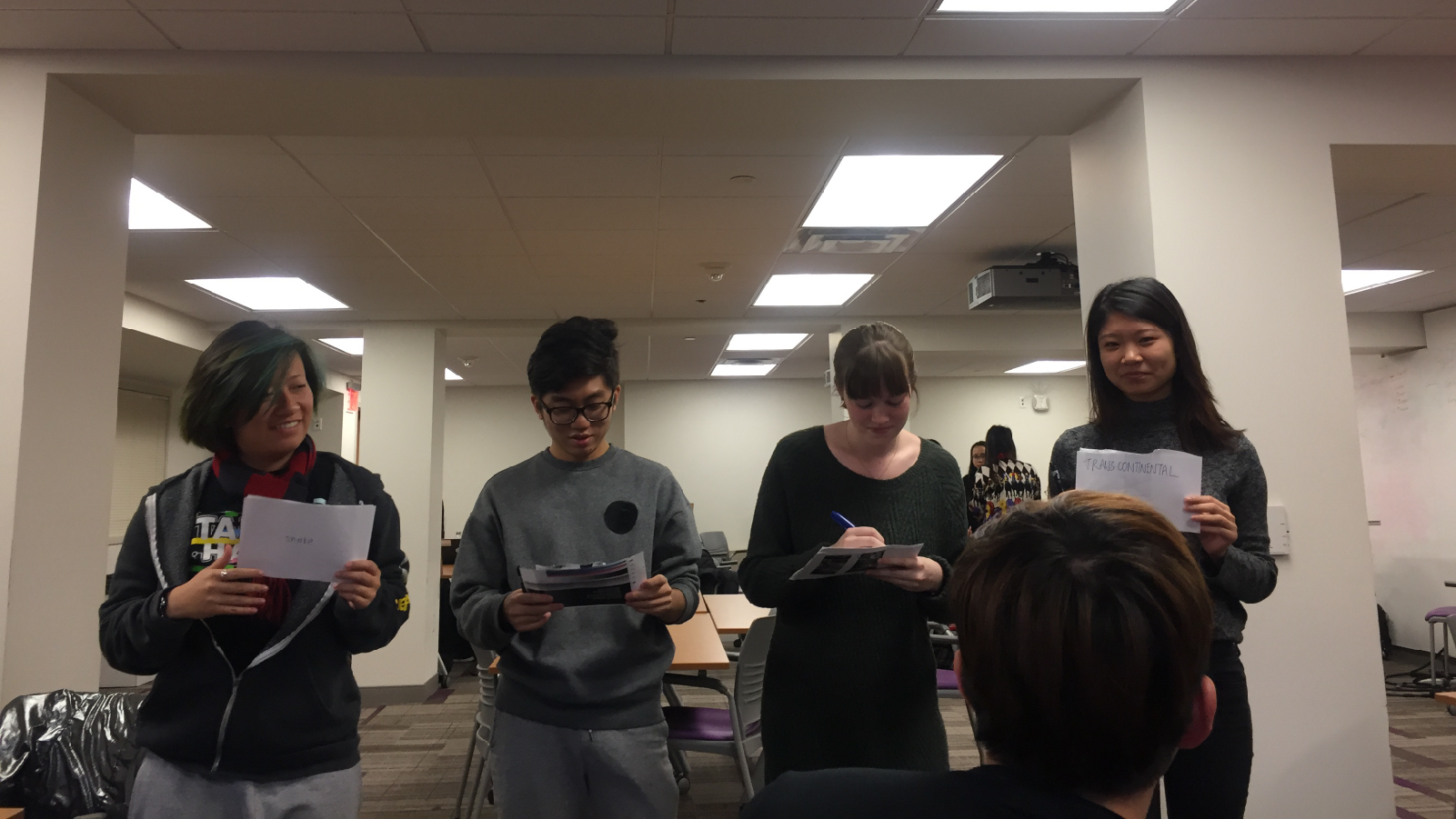
“Zombies” simulating the game with pen and paper words for storytelling. Testing an analogue version helped us quickly see design weaknesses and the need for new balancing mechanics.
Paper prototype testing quickly validated some of the added design elements we introduced. Players had fun once a balance was reached! We continued on with the elements of prompts and audience voting.
Playtesting with the Oculus and a fake speech-to-text assistant. Players had trouble reading the text over moving zombies and other environmental obstacles. We had to implement multiple legibility changes and shift scenery elements.
User Testing Halfway, in VR
The next two weeks were focused on coding and art in the game engine Unity.
About halfway through our build, I led the second round of user testing. Our goals were to quickly make UI and game element improvements before we spent time beautifying art assets or locking things deeper in code.
We only had a few hours to user test, so we had two players play the game as “streamers” telling a story. Our text-to-speech and twitch connection weren’t working yet but we “Wizard of Oz’ed” (faked) it to create a testable prototype.
Both screen recordings and captures of the Oculus Rift were taken (screen captures in VR are great to see what users are focusing their attention on!) Players did two rounds of gameplay, sometimes with elements tweaked if they were having trouble. Then I ran a post interview using the EOTA framework [link], which probes for inner experiences of gaming.
UI and design improvements included:
- A/B testing zombie speed to reach a happy medium
- Outlining zombie text for higher contrast and legibility
- Increasing the visibility of the prompt through a smaller display (it was blocking the players vision)
- Moving the player to the middle of the game space for greater immersion
- Creating an instructional loading screen
Final User Test: Does the Game Improve Streaming Confidence?
After the build, I ran a more in-depth final user playtest, this time with the full Twitch audience participation. I was also interested in our hypothesis that this game might prepare novice streamers to be more confident and entertaining.
I created a pilot experiment to show how I might test this hypothesis (a full sample size could not be reached). I combined our final usability and playtesting with this experiment on improving streamining confidence.
One streamer and viewer per session recieved baseline tests. The streamer’s was also a Streaming Anxiety Scale I modified from estabilished psychological anxiety scales. One group (n=2) played The Talking Dead, while the other played a non-improv VR game, The Lab. A seperate interview was conducted halfway through to gather initial experiences, but a more in-depth group interview was done after the second round of gameplay. I wanted to hear their reactions to the social experience, both separately and together.
The playtest was largely successful in that players and viewers had fun! The main UI elements worked, and the viewer’s chatbot had few issues. A t-test compared The Talking Dead with the control game, and found that our game had a much larger six-point increase in a streaming confience scale. However our sample was too small to draw significant conclusions (p=0.23). All I could say was that there was promise, and this needed to be investigated further.
If I had more time, I would have done repeated measures or diary studies to investigate longer-term effects of the game.
The biggest breakdown however was that streamers and viewers felt distant to one another. Viewers felt that they had some control such as “downvoting” bad stories, but that feedback was too slow and subtle. They wanted to communicate, while streamers also mirrored they had little feedback in real time. Future designs would need to address this, especially challenges we encountered with text-based chat in VR.

Streamers playing the game had a great time, but felt distant from the viewers that were playing in the chat log. There was little feedback between either group.
Insights and Future Directions
A huge insight from our final user testing was the difficulty of socially connecting VR streamers with their audience, especially in a participation game. Since “heads up displays” of fixed chats in VR views can cause nausea and obscure views, it becomes difficult for VR players to parse the chat and actions of their viewers. This could be a huge further area of study and design.
We also showcased our game publicly at Carnegie Mellon and observed groups of people playing live. The laughter and playfulness of playing near one another in person made us think - maybe the game would also work as a party game?
Our code is available on GitHub, and maybe some day when we’re less busy we’ll return to build out increased difficulty, social connection elements such as real-time emoji, or more rigorous experiment testing (such as repeated measures and with real streamers).

